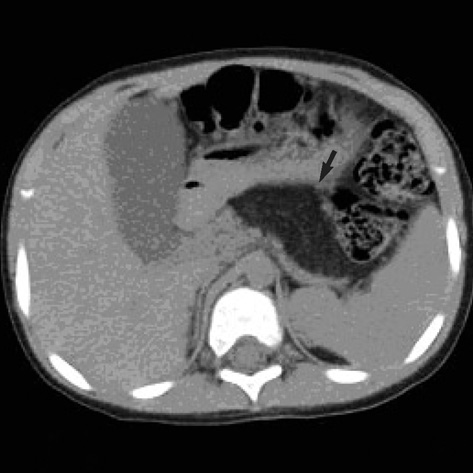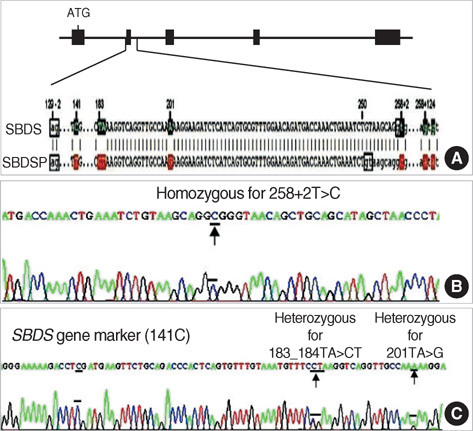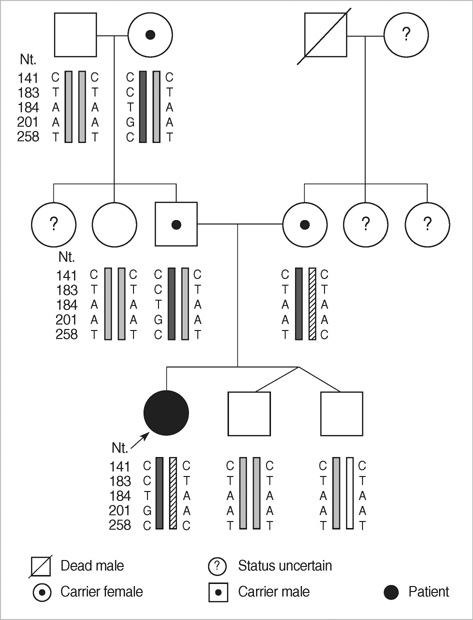J Korean Med Sci.
2008 Feb;23(1):142-145. 10.3346/jkms.2008.23.1.142.
A Case of Shwachman-Diamond Syndrome Confirmed with Genetic Analysis in a Korean Child
- Affiliations
-
- 1Department of Pediatrics, Konkuk University School of Medicine, Seoul, Korea. baedori@hanafos.com
- 2Department of Laboratoty Medicine, Konkuk University School of Medicine, Seoul, Korea.
- KMID: 1786862
- DOI: http://doi.org/10.3346/jkms.2008.23.1.142
Abstract
- Shwachman-Diamond syndrome (SDS) is an autosomal recessive genetic disorder, consisting of exocrine pancreatic insufficiency, chronic neutropenia, neutrophil chemotaxis defects, metaphyseal dysostosis, short stature, dental caries, and multiple organ involvements. Although SDS is the second most common hereditary abnormality of exocrine pancreas following cystic fibrosis in the Western countries, it has rarely been reported in Asia. We diagnosed a case of SDS in a 42-month-old girl, and genetic analysis including the relatives of the patient confirmed the diagnosis for the first time in Korea. She had short stature, steatorrhea, dental caries, and recurrent prulent otitis media and pneumonias. Laboratory studies revealed cyclic neutropenia, and serum levels of trypsin, amylase, and lipase were decreased. Simple radiography revealed metaphyseal sclerotic changes at the distal femur. A CT scan demonstrated a fatty infiltration and atrophy of the pancreas. On direct sequencing analysis of Shwachman-Bodian-Diamond Syndrome gene exon 2 region, the patient was homozygous for the c.258+2T>C mutation and heterozygous for the c.183_184TA>CT mutation and c.201A>G single nucleotide polymorphism. Treatment with pancreatic enzyme replacement, multivitamin supplementation, and regular to high fat diet improved her weight gain and steatorrhea.
Keyword
MeSH Terms
Figure
Cited by 1 articles
-
Two Cases of Shwachman-Diamond Syndrome in Adolescents Confirmed by Genetic Analysis
Won Kyoung Cho, In Ah Jung, Jiyeon Kim, Hyojin Chae, Myungshin Kim, Nack-Gyun Chung, Byung-Kyu Suh
Ann Lab Med. 2015;35(2):269-271. doi: 10.3343/alm.2015.35.2.269.
Reference
-
1. Bodian M, Sheldon W, Lightwood R. Congenital hypoplasia of the exocrine pancreas. Acta Paediatr. 1964. 53:282–293.
Article2. Shwachman H, Diamond LK, Oski FA, Khaw KT. The syndrome of pancreatic insufficiency and bone marrow dysfunction. J Pediatr. 1964. 65:645–663.
Article3. Aggett PJ, Cavanagh NP, Matthew DJ, Pincott JR, Sutcliffe J, Harries JT. Shwachman's syndrome: a review of 21 cases. Arch Dis Child. 1980. 55:331–347.
Article4. Kwak JW, Kim S, Lim YT. A case of Shwachman-Diamond syndrome. Korean J Pediatr. 2004. 47:900–903.5. Park SY, Chae MB, Kwack YG, Lee MH, Kim IH, Kim YS, Kim CS. Allogenic bone marrow transplantation in Shwachman-Diamond syndrome with malignant myeloid transformation: a case report. Korean J Intern Med. 2002. 17:204–206.6. Boocock GR, Morrison JA, Popovic M, Richards N, Ellis L, Durie PR, Rommens JM. Mutations in SBDS are associated with Shwachman-Diamond syndrome. Nat Genet. 2003. 33:97–101.
Article7. Nicolis E, Bonizzato A, Assael BM, Cipolli M. Identification of novel mutations in patients with Shwachman-Diamond syndrome. Hum Mutat. 2005. 25:410–417.
Article8. Woods WG, Roloff JS, Lukens JN, Krivit W. The occurrence of leukemia in patients with the Shwachman syndrome. J Pediatr. 1981. 99:425–428.
Article9. Dror Y, Freedman MH. Shwachman-Diamond syndrome. Br J Haematol. 2002. 118:701–713.
Article10. Vibhakar R, Radhi M, Rumelhart S, Tatman D, Goldman F. Successful unrelated umbilical cord blood transplantation in children with Shwachman-Diamond syndrome. Bone Marrow Transplant. 2005. 36:855–861.
Article11. Mitsui T, Kawakami T, Sendo D, Katsuura M, Shimizu Y, Hayasaka K. Successful unrelated donor bone marrow transplantation for Shwachman-Diamond syndrome with leukemia. Int J Hematol. 2004. 79:189–192.
Article12. Kawakami T, Mitsui T, Kanai M, Shirahata E, Sendo D, Kanno M, Noro M, Endoh M, Hama A, Tono C, Ito E, Tsuchiya S, Igarashi Y, Abukawa D, Hayasaka K. Genetic analysis of Shwachman-Diamond syndrome: phenotypic heterogeneity in patients carrying identical SBDS mutations. Tohoku J Exp Med. 2005. 206:253–259.
Article13. Nakashima E, Mabuchi A, Makita Y, Masuno M, Ohashi H, Nishimura G, Ikegawa S. Novel SBDS mutations caused by gene conversion in Japanese patients with Shwachman-Diamond syndrome. Hum Genet. 2004. 114:345–348.
- Full Text Links
- Actions
-
Cited
- CITED
-
- Close
- Share
- Similar articles
-
- A Case of Shwachman-Diamond Syndrome
- Genetics and genomics of bone marrow failure syndrome
- Allogeneic Bone Marrow Transplantation in Shwachman-Diamond Syndrome with Malignant Myeloid Transformation: A Case Report
- Current insights into inherited bone marrow failure syndromes
- Two Cases of Shwachman-Diamond Syndrome in Adolescents Confirmed by Genetic Analysis




